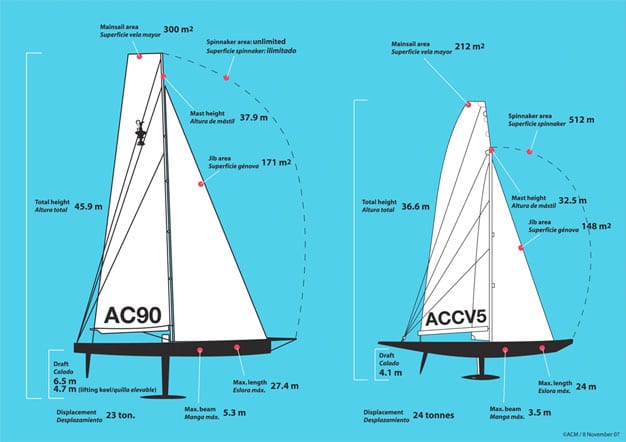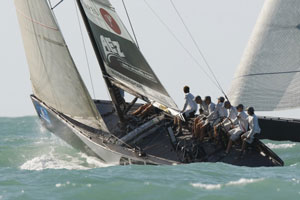
Courtesy Alinghi| |**The AC90 class Alinghi proposed not long after winning the 32nd America’s Cup in early July 2007. **|
[Ed’s note: The author was the technical director for the AC33 class during it’s brief existence as the monohull for the 33rd America’s Cup. In 1988, he was also involved with drafting the IACC rule, which was used for the America’s Cup in 1992, 1995, 2000, 2003, and 2007.]
America’s Cup 33 has been decided, with little comment so far about what kind of boat we might see for AC34. Prior to the last Deed of Gift (DoG) Match in 1988, there had been some serious groundwork for a new, speedy class of yacht to replace the venerable Twelve Metre Class.
We’ve just witnessed the fastest craft ever built for closed-course racing, created with extraordinary innovation and engineering by both teams. AC33 fits the America’s Cup model of its first 100 years-a one-on-one drag race of grand yachts with limited tactical sailing. But, can craft such as that fit the successful event model of the past four decades, with multiple challengers and, for awhile, defenders slugging it out through months of match racing?
There were three fundamental principles underlying the America’s Cup Class of 1988, which has served 5 Matches in 20 years. They bear repeating as plans are being made for a new class.

Raffaello Bastiani/RC 44 Class|
|**When talking about the class for the 34th America’s Cup, Larry Ellison mentioned a scaled-up RC 44 (above). **|
They should be the largest day racing yachts in use;
• They should provide good match racing;
• They should be athletically demanding to sail.
Taken for granted, perhaps, is that they should encourage regular, multi-challenger competition including in events between Cup years.
Coming out of 2007, there was momentum to create a more advanced monohull for the Cup. If you look at the guiding principles for creating the America’s Cup Class in 1988, it looks like Alinghi was on the right track to replace the aging “Version 5” ACC boats. As a concession to the economics of fleet growth, and through a collaboration with 18 candidate challenge teams, the proposed AC90 Class was downsized and refined further to become the 26-meter (85-foot) AC33 Class, whch adopted in early 2009 but put aside after the DoG challenge was confirmed. Further developmental ideas were under consideration at the time, but time had run out on them.
So, now would be a good time to give a new class the best of America’s Cup experts’ collective thinking. BMW Oracle Racing could assemble a solid representation of experienced teams to brainstorm a class that might carry the competition for the next five or so matches.

Courtesy Alinghi| |A side-by-side comparison of the AC33 class (right) with a current Version 5 ACC boat.| Here are some things to consider:
• Racing should include close-quarters combat, pointing to a monohull.
• Boats should be large, although maybe not to the maximum 90-foot LWL of the DoG.
• Boats should be light and carry lots of sail, requiring good stability.
• Consider a wing mast with a soft sail, with some practical limits on the spar’s chord length so it can stay in the boat when ashore in its cradle and exposed to cross winds. Assess mast area as sail area, and let teams experiment with the best trade-offs.
• Consider a canting keel/daggerboard configuration, for ultimate lightness and maximum stability.
• Stay near the existing nominal maximum draft of about 3.5m, as a practical limit for recreational harbors, whether by a canting keel or a lifting dagger keel in the centerplane.
• Keep athleticism in full view, requiring all deck operations to be manual, including grinding winches and raising/lowering the boards.
• Allow powered canting of the keel, to make it fast enough for tacking duels, and considering that it’s out of sight.
• While a canting rig could be engineered, it would be heavy, expensive and complicated in close-quarters tacking. It’s probably not a good idea for these boats.
• Maintain a minimum construction weight per unit area, to have some control over an agreed level of structural adequacy for safety and a reasonable service life.
• A box rule, rather than a rating rule, seems to provide a sufficient balance between establishing a nominal speed potential and enabling worthwhile design development.
At a press conference a few days prior to this Match, Larry Ellison said that he’d favor an aggressive monohull, referring to the excitement that he finds in the RC44 developed by his CEO Russell Coutts. It will be interesting to see what they arrange with the Challenger of Record.
Below is a comparison of the AC33 Class proposed by Alinghi (subsequent to the AC90 class, which was the first go at a new boat for the 33rd America’s Cup).
| ACC Version 5.0 | 33rd America’s Cup Class AC33 | |
| Length overall | 24.5m typical | 26m maximum |
| Length waterline | 18-20m | 26m maximum |
| Beam | 3.3m typical | 4.8m maximum |
| Draft | 4.1m | 5.0m |
| Weight | 26.5 tons (U.S.) | 19.3 tons |
| mast heigh from sheerline | 32.5m | 33.6m |
| Spinnaker area | 512 sq. m | unlimited |
| Mainsail area | 214 sq. m typical | 225 sq. m maximum |
| I from sheerline | 26.1m | 28.5m |
| J | 8.3m | 10m |
| Spinnaker tack from mast | 11.6m (pole) | 13.65m (to end of sprit) |









